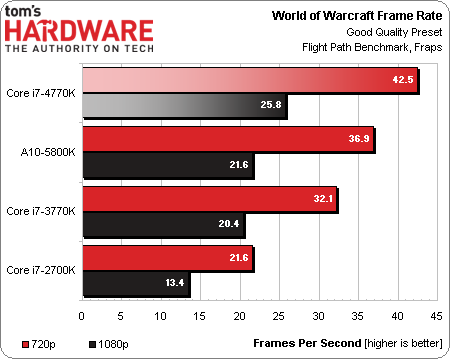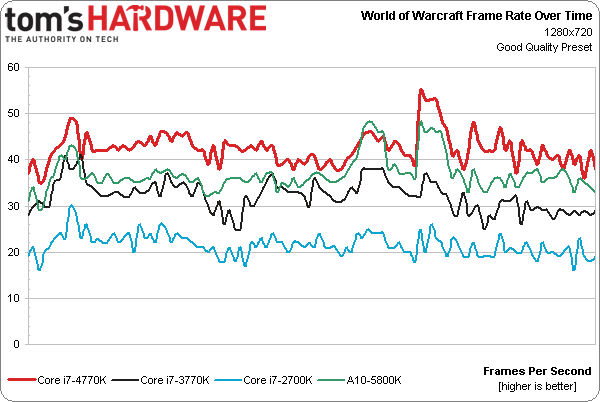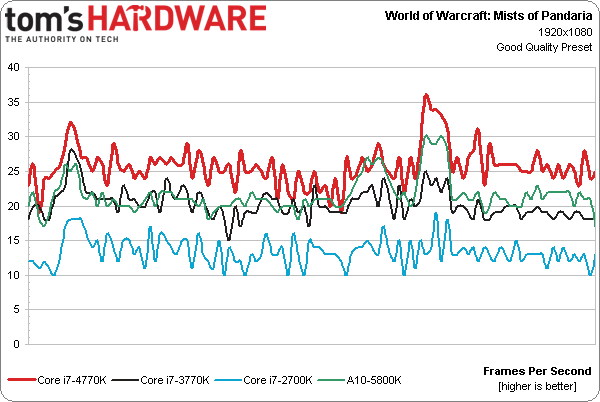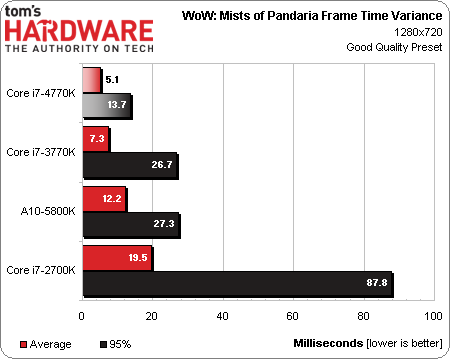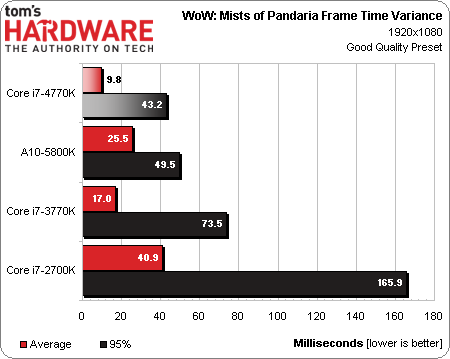The Core i7-4770K Review: Haswell Is Faster; Desktop Enthusiasts Yawn
Intel's Haswell architecture is finally available in the flagship Core i7-4770K processor. Designed to drop into an LGA 1150 interface, does this new quad-core CPU warrant a complete platform replacement, or is your older Sandy Bridge-E system better?
HD Graphics 4600: World of Warcraft: Mists Of Pandaria
In a surprising turn of events, Intel’s Core i7-4770K claims its first and only gaming victory in World of Warcraft. Or maybe we shouldn’t be surprised. This is another notoriously processor-limited title with documented issues on AMD hardware. It looks like the A10 might still be playable at 720p. But it’s symbolic that Haswell, which we know only gets faster when we look at the BGA-based, Iris Pro Graphics 5200-equipped mobile version, already wins in this test with 20 execution units.
The frame rate over time is notably choppier in WoW than the other titles we’ve tested. With that said, Core i7-4770K spends most of its time up above 40 FPS, while A10-5800K hovers in the mid-30 range. Core i7-3770K dips into the mid-20s too often for our tastes.
Haswell again fares well, though playing through WoW at this setting is clearly too much for the HD Graphics 4600 engine to handle. Dialing down to Fair quality might help.
Relative to the other processors we’re testing, Core i7-4770K compares pretty well. In absolute terms, however, almost 14 ms of variance between consecutive frames is palpable. Fortunately, HD Graphics 4600 averages closer to 5 ms at 720p. The experience on AMD’s A10 is noticeably more jittery, particularly in our flight path-based benchmark where the animations are expected to be smooth.
Average and “worst-case” variances alike quickly balloon. This is actually a good representation of how frame time variance and the impact of inconsistent pacing manifest in a game. Naturally, when you’re looking at a tenth of a second difference between the time it takes to serve up one frame and the frame next to it, the effect is exaggerated. But there’s certainly no denying it’s there.
Get Tom's Hardware's best news and in-depth reviews, straight to your inbox.
Current page: HD Graphics 4600: World of Warcraft: Mists Of Pandaria
Prev Page HD Graphics 4600: The Elder Scrolls V: Skyrim Next Page Intel 8-Series Chipsets: Z87 Is Nice-
Danny N Biggest question is if its worth upgrading my cpu i5 750 4.0ghz to Haswell or my gfx card ati 5870 to nvidia 7xx, my main pc use is for Maya, After FX and some fps gaming. Any input would be appriciated cause I'm leaning towards a cpu upgrade atm.Reply -
refillable @Danny NReply
You shouldn't ask here. Perhaps you should get an i7-4770k and a 7970(?) I heard that kepler cards does not perform that good in Maya and Aftereffects (In OpenCL). -
envy14tpe Seriously. What did people expect? Of course it's better but nothing out of the ordinary for Intel.Reply -
enewmen For me it's not about the 10% gain over SB. It's more like a huge gain over a C2Q, floating point performance over SB (should matter later), and lower watts. I hope THG can expand the Power Consumption and Media Encoding later - check the Watts idle more and fast quick-sync media encoding quality loss. My 2 cents..Reply
EDIT:
other sites have reported much lower watts idle, so a lot doesn't make sense or the 4770k has a very slow throttle.
http://hexus.net/tech/reviews/cpu/56005-intel-core-i7-4770k-22nm-haswell/?page=15
http://www.techspot.com/review/679-intel-haswell-core-i7-4770k/page13.html
